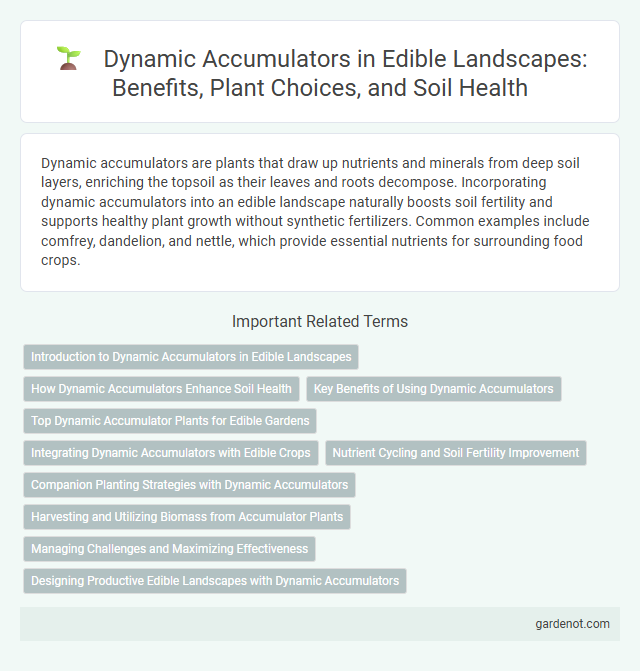Dynamic accumulators are plants that draw up nutrients and minerals from deep soil layers, enriching the topsoil as their leaves and roots decompose. Incorporating dynamic accumulators into an edible landscape naturally boosts soil fertility and supports healthy plant growth without synthetic fertilizers. Common examples include comfrey, dandelion, and nettle, which provide essential nutrients for surrounding food crops.
Introduction to Dynamic Accumulators in Edible Landscapes
Dynamic accumulators are plants that concentrate nutrients and minerals from the soil into their tissues, making them valuable components in edible landscapes. By harvesting and composting these plants, gardeners can naturally enrich the soil, enhancing fertility and promoting healthy growth of food crops. Common dynamic accumulators include comfrey, nettle, and dandelion, each contributing essential nutrients such as potassium, nitrogen, and calcium to support sustainable gardening practices.
How Dynamic Accumulators Enhance Soil Health
Dynamic accumulators such as comfrey, dandelion, and nettle concentrate essential nutrients like potassium, calcium, and nitrogen in their leaves, which are released back into the soil through decomposition, enriching nutrient cycling and soil fertility. Their deep-root systems mine minerals from subsoil layers inaccessible to most plants, improving soil structure and increasing microbial activity. Incorporating dynamic accumulators in an edible landscape supports sustainable soil health by naturally replenishing nutrients, reducing the need for synthetic fertilizers, and enhancing plant growth.
Key Benefits of Using Dynamic Accumulators
Dynamic accumulators enhance soil health by extracting and concentrating essential nutrients such as nitrogen, phosphorus, and potassium in their leaves, which can be composted or mulched to enrich the soil naturally. These plants reduce the need for synthetic fertilizers and improve overall plant growth by creating a more balanced nutrient cycle in edible landscapes. Their integration supports sustainable gardening practices by promoting biodiversity and increasing resilience against pests and diseases.
Top Dynamic Accumulator Plants for Edible Gardens
Dynamic accumulators are plants that draw up vital nutrients from deep within the soil, enriching the surface layer for surrounding edible plants. Comfrey, dandelion, and nettle rank among the top dynamic accumulator plants in edible gardens due to their ability to accumulate potassium, calcium, and nitrogen, respectively. Incorporating these plants enhances soil fertility naturally, boosting growth and nutrient density in vegetables and herbs.
Integrating Dynamic Accumulators with Edible Crops
Dynamic accumulators enhance soil fertility by concentrating essential nutrients like nitrogen, phosphorus, and potassium in their biomass, making them valuable allies in edible landscapes. Integrating dynamic accumulator plants such as comfrey, nettle, and borage with edible crops improves nutrient cycling, supports plant health, and reduces the need for synthetic fertilizers. Planting these accumulators strategically around vegetable beds or fruit trees fosters a sustainable ecosystem that promotes productive, nutrient-rich edible landscapes.
Nutrient Cycling and Soil Fertility Improvement
Dynamic accumulators are plants that enhance nutrient cycling by drawing minerals and nutrients from deep soil layers, making them accessible to other plants in edible landscapes. Their deep root systems mobilize essential elements like calcium, potassium, and nitrogen, which decompose and enrich the topsoil once leaves and roots decay. Incorporating dynamic accumulators such as comfrey, nettle, and dandelion into edible landscapes improves soil fertility, promotes sustainable crop growth, and reduces the need for synthetic fertilizers.
Companion Planting Strategies with Dynamic Accumulators
Dynamic accumulators in edible landscapes enhance soil fertility by drawing up nutrients like potassium, calcium, and magnesium from deep within the soil profile. Incorporating these plants as part of companion planting strategies improves nutrient availability for neighboring crops, boosting growth and resilience naturally. Effective use of accumulators such as comfrey, dandelion, and yarrow maximizes the benefits of organic nutrient cycling and pest suppression in permaculture designs.
Harvesting and Utilizing Biomass from Accumulator Plants
Dynamic accumulators enhance edible landscapes by harvesting nutrient-rich biomass from plants such as comfrey, nettle, and yarrow, which concentrate minerals like nitrogen, potassium, and phosphorus. Utilizing this biomass as mulch, compost, or herbal fertilizer boosts soil fertility and supports sustainable plant growth without synthetic inputs. Regular harvesting prevents overgrowth, promotes continuous accumulation of essential nutrients, and integrates natural cycles to maintain a resilient, productive ecosystem.
Managing Challenges and Maximizing Effectiveness
Dynamic accumulators enhance edible landscapes by extracting and recycling essential nutrients from the soil, improving plant health and yield. Managing challenges like potential toxicity and plant incompatibility requires careful species selection and monitoring soil conditions. Maximizing effectiveness involves integrating accumulators with diverse crops to sustain soil fertility and promote ecosystem resilience.
Designing Productive Edible Landscapes with Dynamic Accumulators
Dynamic accumulators are plants that gather essential nutrients from deep within the soil, enriching the surface layers and boosting soil fertility for edible landscapes. Incorporating species like comfrey, nettle, and yarrow into garden design can improve nutrient cycling, support plant health, and increase crop yields. Strategic placement of these accumulators enhances overall ecosystem productivity and sustainability in edible landscape systems.
Dynamic accumulator Infographic

 gardenot.com
gardenot.com